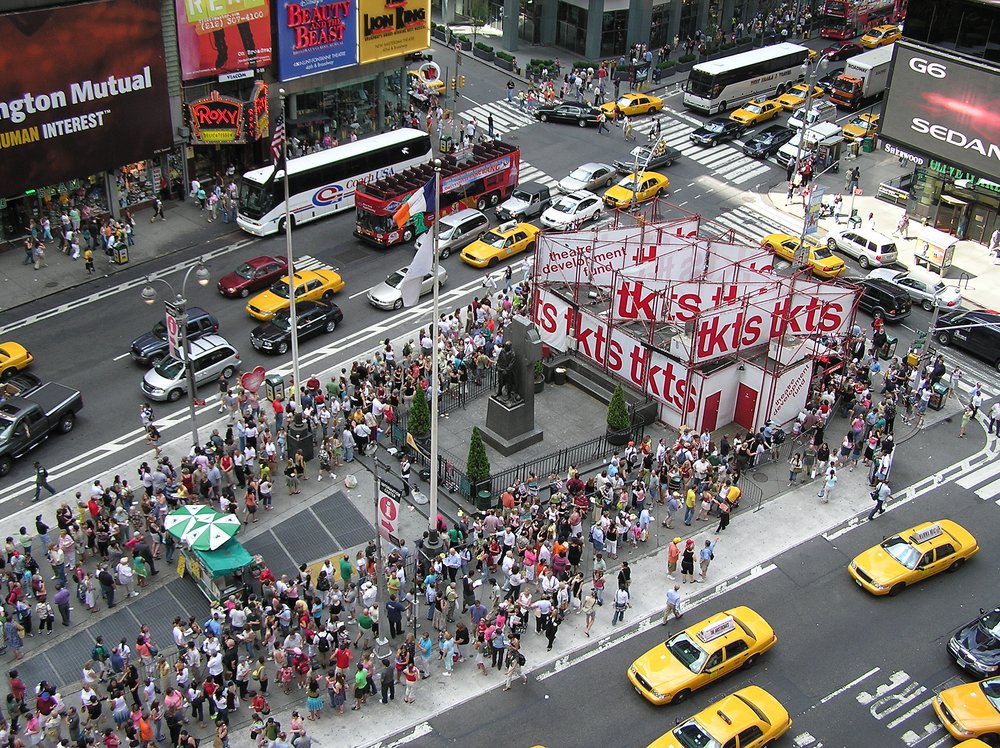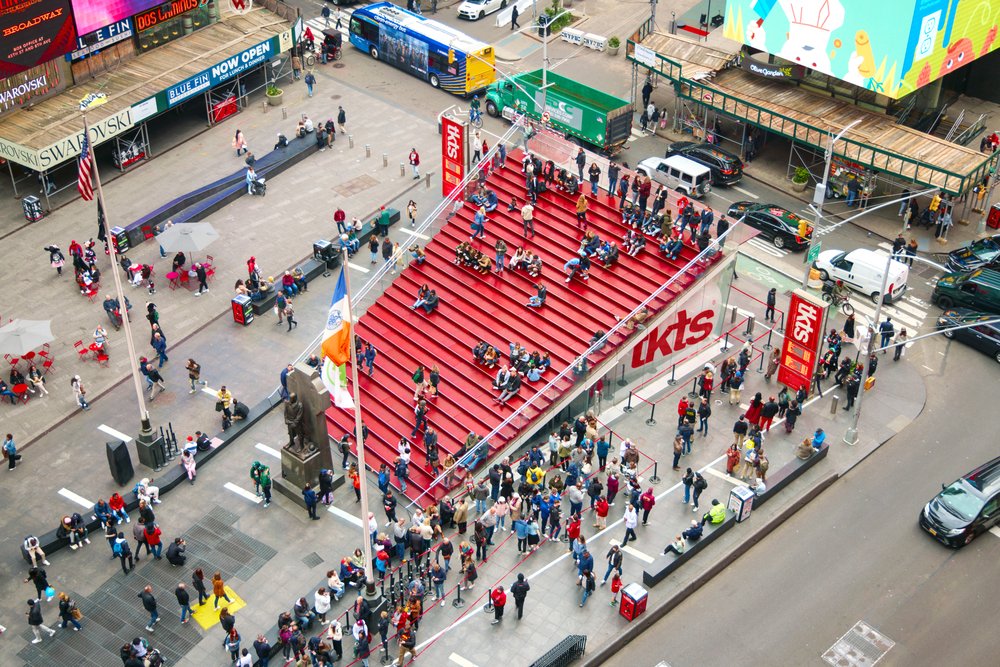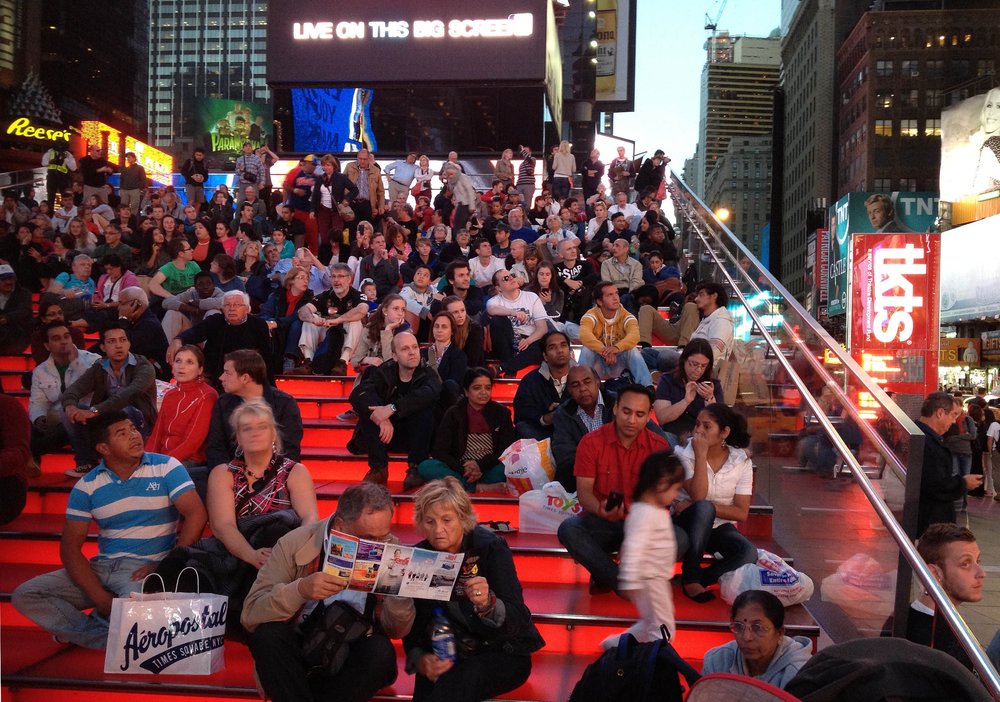Bargains on Broadway: How TKTS helped to save theater and Times Square
June 23, 2023, 9 a.m.
Envisioned as a way to help rejuvenate the theater district in 1973, the TKTS booth has evolved to serve a continuing demand for affordable tickets.

On a recent Sunday afternoon, business was booming at the TKTS booth on Times Square. As street performers dressed as Elmo and Iron Man enticed visitors to snap photos nearby, a long line snaked around the booth, with people waiting to snap up theater tickets at a dramatic discount. Visitors congregated and chatted on the bright red staircase that was added to the booth in a 2008 makeover.
“It’s a famous place,” said one member of the queue, Helena Rospota. She and her partner were on holiday from Lviv, Ukraine, and were waiting to buy tickets for “New York, New York.”
“We are in New York just for today,” Rospota explained. “We [are] here because we want to see [a] good performance on Broadway. That's why we stand in this line and wait for tickets.”
It’s a dramatic change from when the TKTS booth opened 50 years ago on June 25, 1973. At that time, the theater district was a place to avoid and Broadway was in a state of crisis.
“The city was depressed, and Times Square was a disaster,” said Bob Mayers, the architect who helped design the booth and its famous all lowercase logo.
“There was very little pedestrian activity,” he said. “It was considered dangerous. There were muggings. People were afraid to come down to this area at night, especially. And the theaters were half empty.”

As they sought a solution, Mayor John V. Lindsay and his administration teamed up with the Theatre Development Fund. Their response was to create a ticket booth that sold same-day tickets for Broadway shows at half price, plus a modest service charge. An inventory of unsold tickets would be provided by the shows’ producers.
The Parks department found an abandoned trailer in Central Park, and punched a couple of holes in it for ticket windows. Mayers and his partner, John Schiff, designed canvas sails on pipes to make the trailer stand out.
Still, doubts remained, says Victoria Bailey, the TDF's current executive director. “There really was a sense that this wasn't necessarily going to work – that Times Square was so rough, who was going to come?” she said.
Lindsay personally dedicated the booth, which caught on right away. The morning after it opened was rainy, Bailey says, but when two box office workers turned a corner toward the booth, “all they could see was umbrellas,” Bailey said.
Early on, she says, it was mostly New Yorkers and suburbanites who visited the TKTS booth. “Then tourists started using it.”
Emanuel Azenberg, a theatrical producer, says TKTS helped bring in new theatergoers. “It gave access to younger people, tickets to shows,” Azenberg said. “It was a big boon to the industry.”
According to TDF, 30% of the people who use TKTS have never been to a Broadway show before. Over its 50-year history, the booth has sold 68.6 million tickets, generating $2.68 billion in revenue for Broadway and off-Broadway productions.
“It proved what I think has always been the case, and will always be the case: that there are people who want to go to Broadway, who can't afford a full price ticket,” Bailey said.

Over the decades after TKTS opened, Times Square cleaned up and Broadway boomed – and ticket prices soared. When “A Chorus Line” opened in 1975, its top ticket went for $15. But prices rose considerably during the 1980s and ’90s – “The Life and Adventures of Nicholas Nickleby” famously broke the $100 barrier in 1981. Orchestra-level tickets often sell for more than $200 now, with premium seats fetching even more.
“The booth becomes more and more a fixture, because in order to solve all our economic problems, we raise the price,” producer Azenberg said of the gradual increase. “So therefore, the discounted price becomes a major attraction.”
Business remained brisk, and TDF opened satellite TKTS booths in Brooklyn, at the World Trade Center and in Lincoln Center. The availability of half-price tickets almost certainly helped keep some shows running for years.
“Shows like ‘Phantom’ and ‘Chorus Line,’ this is unscientific, but my guess is over time, the booth was responsible for five or six years of their run, at least,” Bailey said.
Along with its successes, TKTS has endured challenges over the years. Sales were depressed in the period after 9/11, and more recently the effects of the COVID-19 pandemic dampened ticket purchases. And, producer Azenberg says, there are now other ways to get discount tickets, including websites and apps.
“If you can start getting half-price tickets on the computer, will that affect the ticket booth in the middle of the street, where you stand online?” Azenberg said.

Now, TKTS offers its own app, which indicates what shows are available on a given day. That’s how Long Islander Casey Salter learned that tickets for “Funny Girl” were on offer, and made her way to line up in Times Square alongside Rospota and everyone else.
Salter, a big theater fan, says she and her friends use the booth and also participate in lotteries and vie for rush tickets. “There's a lot of affordable theater options,” she said. “I don't necessarily have the money to see full price, so it's great that there is so much available for people to still get out and see theater.”
But the iconic Times Square booth retains its appeal, and in 2008 it got a welcome makeover – including that red staircase where tourists and locals alike meet and chat. Bailey, the TDF director, says that’s been a real draw.
“It has become that kind of town square – which I think is really powerful, because theater is part of community,” she said. And on Wednesday morning, the booth’s 50th anniversary will be officially celebrated on those red steps, in an event that includes a performance and audience sing-along.
“I guess it became a symbol of New York,” Mayers said of the once-modest booth he helped put on the map. “It is amazing, I can date movies by seeing it – and if you see it, you think of New York.”